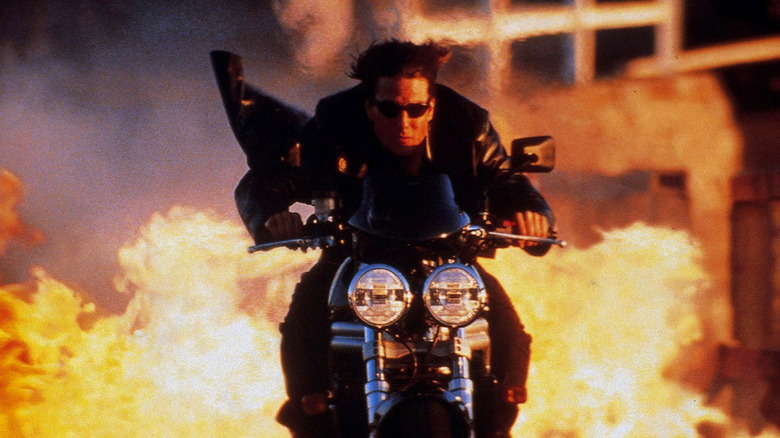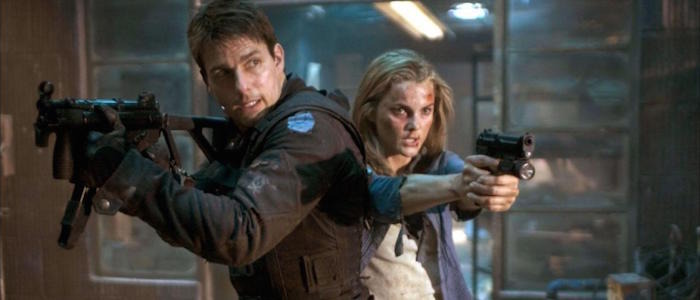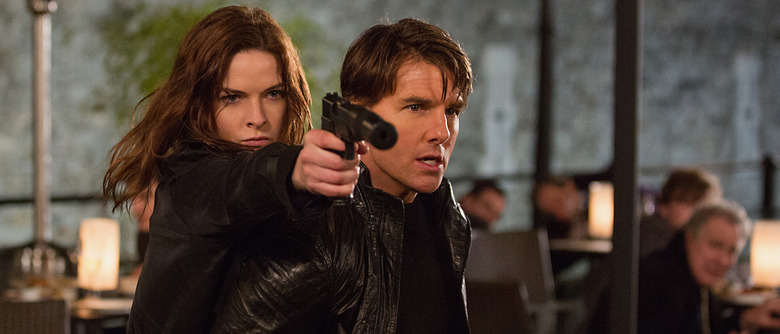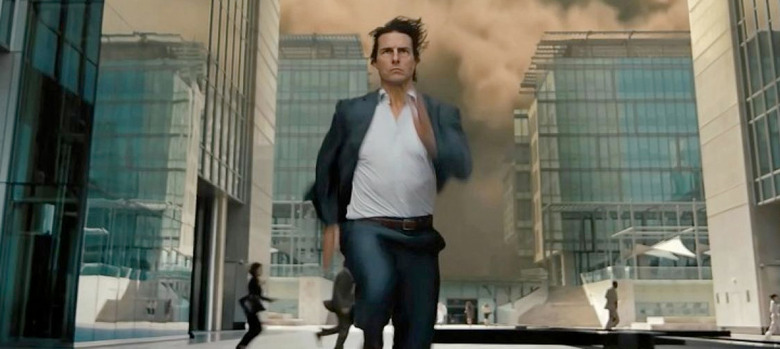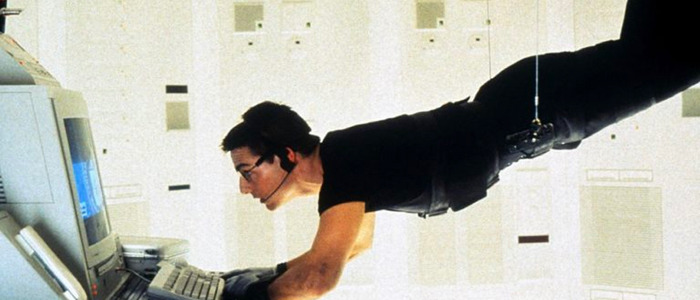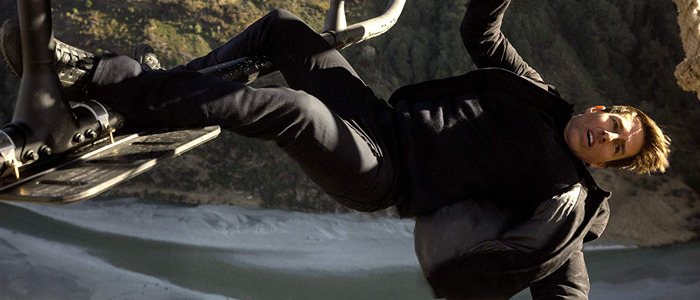Should You Choose To Accept It: The 'Mission: Impossible' Movies Ranked From Worst To Best
What if Tom Cruise was James Bond? The Mission: Impossible series, now six films strong, is the answer. Through the decades-spanning franchise, Cruise has played a secret agent surrounded by gadgets, spycraft, and gorgeous women. The major difference between Ethan Hunt of the IMF and James Bond of MI6 is that Hunt has a habit for indulging in death-defying stunts.
Which is the craziest? Which film is the best? Where does new film Mission: Impossible – Fallout fall in the series? Read on.
(Major spoilers for the first five films in the series and minor spoilers for Fallout lie ahead.)
6. Mission: Impossible 2 (2000)
If the first Mission: Impossible is all about Tom Cruise embodying the origin story of an Americanized James Bond, then the second Mission: Impossible is all about Tom Cruise trying very hard to be cool. He feels like a human version of Poochie from The Simpsons. When we first see Ethan, he's climbing up a cliff face, 'cause why not. Throughout the film, Ethan (with longer hair than the close-cropped 'do Cruise had in the original) dons snappy dark sunglasses, wears black, rides motorcycles, and sports a slick black leather jacket. Because, see, he's cool.
The self-consciously forced sense of coolness is amplified by the man behind the camera: John Woo. Woo was only a few years removed from Face/Off, and while this movie isn't quite as gory or bombastic, it has its moments. The basic premise is intriguing enough—Ethan faces off (ahem) against a rogue IMF agent named Sean Ambrose, who's an inverted version of our hero—but Woo's style is something you get behind or you don't. (You can gather which side I'm on.)
Woo's recognizable trademarks — slow motion, physics-defying stunts, a shit-ton of doves — are all present, and unavoidably goofy. (When, in a slow-motion shot, we see a dove fly in front of Ethan, basically introducing his presence, it's hard not to laugh.) The climactic battle between Hunt and Ambrose, you may recall, involves them playing chicken with motorcycles, after which they run into each other, dive off said motorcycles (which explode in mid-air), and grapple to the death.
What's unique about this movie, much like its predecessor (we'll get there in a bit), is how much of it belongs to the director. It's understandable to see this as Tom Cruise's franchise, both in terms of who headlines the film and who produces it. But Mission: Impossible is unquestionably a Brian de Palma film, and Mission: Impossible 2 is unquestionably a John Woo film. Cruise was likely careful in selecting the filmmaker, but this isn't a case where a director comes on board specifically to service the star's vision. (Or Tom Cruise's vision was, "I want John Woo to make a John Woo movie featuring me.")
Mission: Impossible 2 features little continuity with the original, aside from Ethan and his cohort Luther Stickell. Otherwise, the cast is new, including an uncredited, pleased-to-get-paid Anthony Hopkins as Hunt's superior, and his future Westworld co-star Thandie Newton as Nyah Nordoff-Hall, a gorgeous thief whose previous romantic connection to Ambrose makes her a vital part of Hunt's mission to stop Ambrose from selling a murderous virus to terrorists.
As with the first film, this sequel heavily pays homage to Alfred Hitchcock, specifically his masterpiece Notorious, in which a sly secret agent recruits a beautiful woman to use her looks and charm to seduce an evil man. (The original Mission: Impossible has lots of Hitchcock allusions, but none of them are so specific to one film and the action isn't...goofy.) Part of what makes the homage odd is that the second half essentially jettisons it; Newton is indeed jaw-droppingly beautiful, enough so you buy Hunt and Ambrose battling over Nyah, but the character is a prop in the second hour.
The other problem plagues the whole franchise: the villain is pretty dull. Dougray Scott plays Ambrose, a Scottish IMF agent who we first see in disguise as...Ethan. (He wears that mask often in the film. Lots of masks in this one. So, people take their...faces off. Ahem.) The notion that Ethan and Ambrose are two sides of the same coin allows for Ambrose to spot Ethan's character traits and exploit them as flaws. During a mid-film break-in, Ambrose is smart enough to know what Hunt will do; he also mocks Cruise's constant, shit-eating grin. But Scott can't make Ambrose terribly exciting. He's slightly better than Jim Phelps was in the original, but only just. The rest of the movie can't even begin to compare.
5. Mission: Impossible III (2006)
In 2018, Mission: Impossible III is compelling to watch for unexpected reasons. In this film, the series doubles down on the idea that Ethan Hunt is both charming and insane. (Considering how public opinion on Tom Cruise soured in the mid-2000s, it's interesting subtext.) Think of an early scene, when Ethan co-hosts a party with his fiancée Julia (Michelle Monaghan). She's talking to friends in the kitchen, telling the story of how she met Ethan; he's 50 feet away in an entirely different room, spying on them by reading their lips before he corrects her (again, from 50 feet away in a house full of music and chatter) about the name of the lake where they met. He's charismatic. But he's nuts.
This movie also features the best possible distillation of Tom Cruise in cinema. By the Shanghai-set climax, Ethan has been put through the ringer emotionally and physically. He's failed to rescue one of his IMF trainees (Keri Russell), leading him to try and nab a nefarious arms dealer, Owen Davian (Philip Seymour Hoffman). Soon enough, Davian escapes, kidnaps Julia, and blackmails Ethan into robbing something called the Rabbit's Foot in 48 hours, or else he'll kill Julia. When Ethan learns of Julia's location, even with an explosive charge in his head, he can only get there on foot.
So what does Ethan do? He does what Tom Cruise does best, and most compellingly on screen: he runs. J.J. Abrams, in his feature directorial debut, films Cruise running down the Shanghai harbor frantically, in an unbroken 20-second shot barely keeping pace with the star. (In this specific movie, 20 seconds is a long time for a single shot; it's a bit too jittery.) Why not 20 seconds? There's something weirdly hypnotic just watching Tom Cruise run and run and run.
The movie surrounding that scene is as straightforward as these films get. Abrams, and co-writers Alex Kurtzman and Roberto Orci, tells a story with another IMF mole but in a way that feels familiar to their TV work. Simon Pegg's first turn as IMF techie Benji Dunn feels like a British version of the nerdy Marshall from Alias. (Cruise chose Abrams only after binge-watching that ABC drama.) The twists regarding the mole feel similar to the back-and-forths on Alias about which characters are working for or against the enemy; hell, having Russell appear is a nod to Alias being pitched as "Felicity as a spy".
That said, Alias proved a decent testing ground for Abrams' feature career. He's come a long way since then — would you have believed that this film's director would take the lead for new Star Wars films? — but Mission: Impossible III is a solid start. The action sequences, from a rescue in Berlin that culminates in a chase between two helicopters in the middle of wind-powered fans to a massive shootout on the Chesapeake Bay Bridge, are suitably intense without featuring insanely death-defying stunts. There's even continuity here, though you have to listen for it — when Luther lays out a plan to break into a Shanghai laboratory to steal the Rabbit's Foot, he offhandedly mentions that Langley was comparatively a cakewalk.
This film's most remarkable/frustrating element is Owen Davian. Hoffman is the series' best villain, while also being painfully underused. He has basically four scenes and not even a half-hour of screen time. When he shows up, he makes an incalculable impact. In the opening scene, which takes place near the finale — an in medias res storytelling choice that Abrams used a lot on Alias — Owen makes good on a threat as he seems to kill Julia because Ethan didn't give him the Rabbit's Foot. Ethan, who thought he had given over the Rabbit's Foot, tries to negotiate but fails. It's a fake-out, but this scene's tension isn't topped by the rest of the film. Mission: Impossible III is a good movie. Shame that Abrams started with the best scene and left his villain on the sidelines.
4. Mission: Impossible - Rogue Nation (2015)
It only took this franchise until the fifth film to craft a genuinely fascinating female character. That delay is largely unforgivable — the main female characters in the first two films are essentially seductive props, Ethan's wife Julia is mildly capable but not prepared for the intensity of her husband's real life, and Paula Patton's agent in the fourth film is a slight improvement. Thankfully, in this Christopher McQuarrie-helmed entry, Ilsa Faust is a very welcome, thrilling addition.
McQuarrie, who did uncredited rewrites on Ghost Protocol, sets things up so Ethan has to take down The Syndicate, an anti-IMF that causes major unrest across the globe with no oversight. Ethan, along with a small team, tries to stop The Syndicate although no one else believes they're real. Throughout the mission, Ethan is both aided and deterred by deep-cover MI6 agent Ilsa Faust (Rebecca Ferguson) as they each try to stop Syndicate leader Solomon Lane (Sean Harris) from further mayhem.
The first scene of Rogue Nation is exceptionally memorable as Tom Cruise — yes, he's playing Ethan, but come on — hangs on the side of an airplane as it takes off from a runway in Belarus. Ostensibly, Ethan is trying to waylay a shipment from its true destination, but the stunt is jaw-dropping because...Tom Cruise was hanging on the side of an airplane. He'll do anything to entertain an audience; endangering his life is just part of the process.
To wit: as with the other great films in this franchise, the half-hour sequence in the middle of the film is excellent. The first film has the CIA break-in; Ghost Protocol had Dubai. Rogue Nation has Casablanca, as Ethan, Ilsa, and Benji Dunn (Simon Pegg) decide to break into an underground chamber with a very sensitive bit of data. Benji can only steal it if Ethan breaks into an underwater security silo and switches profile data to match Benji's physical gait. So Ethan has to hold his breath for three minutes — apparently, Cruise held his for six minutes in filming the stunt — and is only rescued by Ilsa. After he's literally revived from the dead by a woman for the second time in the franchise, Ethan chases Ilsa — who's absconded with the data — through the streets of Casablanca, first by car and then by motorcycle.
Rogue Nation being placed here on this list is a testament to how exciting the later Mission: Impossible films are. The concept of the Syndicate is intriguing — instead of the anti-Ethan Hunt in Mission: Impossible 2, we have an entire organization that runs against his principles — but Harris is utilized so briefly that he barely makes an impact. He looks distinctively evil, and his whispery menace is unique, but as is often the case, the villain is in too little of the film to be scary.
That said, McQuarrie has crafted a series of impressive action setpieces. An early section shot in the Vienna Opera House is a great throwback to Alfred Hitchcock's thrillers, as the Chancellor of Austria is unknowingly about to be shot in sync with the final note of an aria in the opera Turandot. (This series is heavily indebted to Hitchcock.) Though no sequence in Rogue Nation tops anything in Ghost Protocol, it's another exciting adventure in the busy life of Ethan Hunt.
3. Mission: Impossible - Ghost Protocol (2011)
It's now hard to believe, but at one point, Ghost Protocol was initially designed to have Ethan Hunt pass the torch to a new IMF hero, William Brandt (Jeremy Renner). Nothing against Renner, but this film proved the obvious: Tom Cruise is this franchise. It would not work without him.
This time, we meet Ethan in prison, nonchalantly throwing a rock against the wall a la Steve McQueen in The Great Escape. He's broken out by two IMF agents: Jane Carter (Paula Patton) and former techie Benji Dunn (Simon Pegg). The three of them, and Brandt, end up the final remnants of the IMF after the organization is framed for bombing the Kremlin by an extremist (Michael Nyqvist) who wants to steal a nuclear weapon to detonate it in San Francisco.
The IMF with its metaphorical back against the wall makes for a phenomenally entertaining adventure, helmed by longtime Pixar stalwart Brad Bird. This was Bird's first live-action film, and it's a shame that he hasn't been brought back to make another M:I film. His clean, fluid directing style isn't flashy or jittery, but it produces exceptionally entertaining action sequences.
Though Bird didn't write this film, it's easy to see parallels to his earlier films. As in The Iron Giant, there's fears of nuclear war; most importantly, as in The Incredibles, there's a high emphasis on a group of special people working together. Ethan Hunt, Benji Dunn, William Brandt, and Jane Carter may not be a biological family, but it's made eminently clear that they can only triumph by working together, not separately.
The themes are less important to Ghost Protocol than the success of lengthy setpieces. Ethan's mission to break into the Kremlin leads to the aforementioned framing of the IMF. With Brandt in tow, the small team heads to Dubai to stop an exchange between the extremist and a deadly assassin, in a 30-minute sequence that is arguably the best work of Bird's career. Cruise's jaw-dropping stunt of climbing up the Burj Khalifa is well met by ensuing hand-to-hand combat and a sandstorm-set car chase. It's bursting with action, and is the film's literal and figurative high point.
Ghost Protocol isn't my top pick — I know, I'm history's greatest monster — because the last third doesn't measure up. Its muted qualities are simply less satisfying than what happens in Dubai. That said, the final scene introduces some surprising continuity in three places: Ving Rhames makes a very brief cameo, as does Michelle Monaghan as Ethan's thought-dead wife. And, though people might not have noticed it initially, this film's final dialogue pays off in Rogue Nation, as Ethan is alerted to a mysterious group called...The Syndicate. This film's climax may not live up to its mid-section, but the mid-section is basically perfect.
2. Mission: Impossible (1996)
A big trend in '90s-era cinema was movie adaptations of old TV shows. Most of these were, to quote something set in the era where most of those shows originated, not great, Bob! Here's a few examples: My Favorite Martian, The Mod Squad, Wild Wild West, The Beverly Hillbillies, and The Flintstones. A couple TV-to-movie adaptations were decent; one even garnered a Best Picture nomination. (Do you remember that The Fugitive got a Best Picture nod? It did! Deservedly so.)
And then, there was Mission: Impossible. Tom Cruise's foray into franchises was his first film since Interview with the Vampire, re-establishing him as an action hero. The first Mission: Impossible unquestionably feels different from the rest of the series. Yes, there's wild action. Yes, there's a jaw-dropping centerpiece sequence with Cruise all but beating himself up to entertain audiences. But as is evident from the man behind the camera, this Mission: Impossible is most indebted to Alfred Hitchcock for its sweaty suspense.
This was the first film Tom Cruise produced, so he was instrumental in choosing Brian de Palma of Carrie, The Untouchables, and Hitchcockian homages like Blow Out as director. Here, de Palma balances his crowd-pleasing and arthouse halves quite well. Ethan Hunt aptly meets the Hitchcock archetype of the Wrong Man: the cocky IMF agent is part of a team led by Jim Phelps (Jon Voight) to retrieve an encrypted list of all undercover agents from the hands of a nefarious thief. When everyone on the team, save Ethan, winds up dead, he teams up with Phelps' wife (Emmanuelle Beart), an enigmatic French tough guy (Jean Reno), and IT whiz Luther Stickell (Ving Rhames) to clear himself as an accused IMF mole.
Conventional wisdom suggests that this movie makes no sense. That's unfair because most blockbusters are equally convoluted; frankly, this movie's fairly clear on its own. After Hunt evades capture, he knows that, to clear his name, he must find the real list and, thus, its buyer. That process leads to the masterful CIA-set sequence, a lengthy homage to the '60s-era heist film Rififi, in which Ethan, Luther, and Reno's character steal the list in, as Ethan hisses, "absolute silence."
These films are all sequence-based; the first is no different. The opening failed mission leads to the CIA heist, which leads to Ethan's discovery that Phelps is a) alive and b) the true mole, which leads to the final action sequence in and on top of the Chunnel. Unlike the other films in the series, the finale is a lot of fun, not a comedown from the mid-point action. It's utterly ridiculous — a helicopter flying in the Chunnel is delightful nonsense — but viscerally exhilarating.
However, like most of the series, this film's villain is weak. Fans of the TV series were understandably infuriated to find out that its hero, Jim Phelps, was the villain of the adaptation. I get why fans were disappointed to see this turn into the Tom Cruise Show. (Voight's performance as Jim Phelps reads as very bored.) But Cruise's presence is magnetic and intense. Though Mission: Impossible doesn't push Cruise to his furthest limits, it remains one of the most compelling entries in the franchise, if only because de Palma's ability to craft suspense even from a single drop of sweat remains unparalleled.
1. Mission: Impossible – Fallout (2018)
Yes, the newest entry in the franchise is also the best. In many ways, Fallout pays off on elements seeded throughout its good predecessors. (Sorry, Mission: Impossible 2.) Ethan's long-dormant relationship with his wife Julia, his constant willingness to prioritize one life over many, and even his oddly flirtatious/combative connection with the arms dealer Max all come up in Fallout, a genuinely superlative action film.
And what action there is! As has been the case in the last two entries, Fallout writer/director Christopher McQuarrie (the first M:I director to helm more than one entry) stages his action sequences around one very important takeaway: that's really Tom Cruise doing all this shit. So yes, that's really Tom Cruise flying a helicopter in the snowy mountains outside Kashmir. And yes, that's really Tom Cruise riding a motorcycle the wrong way around the Arc de Triomphe. And yes, that's really Tom Cruise jumping onto the roof of a building in London, breaking his ankle in the process. There is a tense, almost tactile quality to the exhilarating action in Fallout, because of its practicality. Whatever CG is here feels largely invisible, while every punch, kick, wince, or stumble feels painfully real.
Following up the end of Rogue Nation, Ethan is plagued by nightmares in which his choice to let Solomon Lane (Sean Harris) live has dire consequences for the world at large. Soon enough, those nightmares come close to being true: he chooses to save his old friend Luther instead of grabbing three plutonium cores, letting those fall into the hands of Lane's allies, now called The Apostles. To stop them before they detonate a nuclear weapon, Ethan has to work with a forceful CIA agent named August Walker (Henry Cavill, mustache and all) along with his regular cohorts.
At one point, after Julia steps out of Ethan's nightmares into reality, she asks Luther how her old hubby is. "You know. Same old Ethan," he smiles. In some ways, of course, that's not wrong. Many of the tropes that mark the earlier Mission: Impossible movies are here: there is once again a superior officer who doubts the value of the IMF, there is once again the threat of an American agent working against the cause of good, there are once again death-defying stunts, and so on. Fallout works less because of shocking twists — though there are a couple satisfying reveals — and more because the action is just that incredible.
There are a host of exceptionally entertaining setpieces here, though my pick goes to the chase sequence in Paris, which starts with Ethan and August play-acting as the enemy to grab Lane, involves motorcycle chases, and culminates in Ethan maneuvering a car around the tight streets of Paris with a very unexpected passenger. But the HALO jump shown in the trailer, a vicious brawl in a Parisian bathroom, a foot-chase through London, and the jaw-dropping helicopter battle in the finale are just about as wonderful to experience. The director Howard Hawks is said to have defined a great movie as "three good scenes, no bad scenes". Mission: Impossible – Fallout, which is arguably the best action movie in a very long time, period, is all good scenes. It's a hell of a thing.

